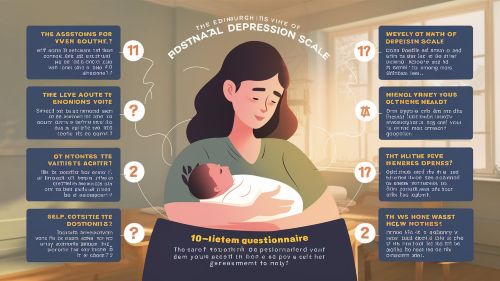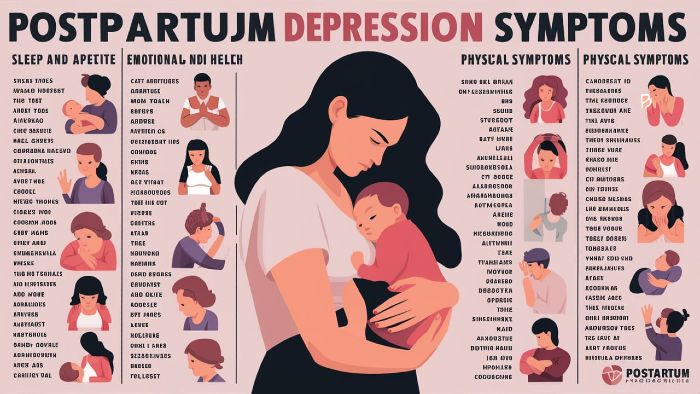When you hear the term “postpartum depression,” what comes to mind? For most people, it’s the image of a new mother crying, unable to feel the joy she’s “supposed to” feel. While that is certainly a part of it, it is a dangerously incomplete picture.
Postpartum depression (PPD) is a complex and multifaceted illness. It can whisper as a constant, humming anxiety. It can roar as a sudden, terrifying rage. It can feel like a heavy, leaden numbness that hollows you out from the inside.
If you are wondering if what you’re experiencing is PPD, you need more than just a stereotype. You need a comprehensive list. You need to see your own secret struggles reflected back at you, to know that you are not alone and that what you are feeling has a name.
This is that list.
Use this as a checklist, a guide, a tool for self-understanding. This is not a diagnostic tool—only a healthcare professional can provide a diagnosis. But it is a starting point for a conversation that could change, and even save, your life.
First, The Crucial Distinction: Baby Blues vs. PPD
Before we dive into the full list, it’s essential to distinguish PPD from the very common “baby blues.” Conflating the two can cause mothers to dismiss serious symptoms.
- The Baby Blues: Affects up to 80% of new mothers. It starts 2-3 days after birth and lasts no more than two weeks. It involves mood swings, weepiness, and feeling overwhelmed, but it resolves on its own without treatment. You still have moments of happiness.
- Postpartum Depression (PPD): A clinical mood disorder that can start anytime in the first year after birth. Its symptoms last for more than two weeks and often worsen without professional treatment. It significantly impairs your ability to function.
Key Takeaway: The two-week mark is your guide. If you have been struggling for more than two weeks, it’s time to consider that it might be more than the baby blues.
The Full List of PPD Symptoms: A Head-to-Toe Checklist
PPD affects every part of you. We’ve broken the symptoms down into four main categories: Emotional, Behavioral, Cognitive, and Physical. You may not experience all of them, but if several of these feel deeply familiar, it’s a strong sign you need to seek support.
[Use the WordPress “Columns” block to arrange these categories to make them more scannable.]
Emotional Symptoms: The Internal Storm
This is the core of what you feel day-to-day.
- Persistent Sadness and Despair: This is more than just feeling down. It’s a heavy, pervasive sense of misery that doesn’t lift. It can feel like a dark cloud is following you, coloring every experience.
- Intense Anxiety or Panic: Your mind may race with constant, uncontrollable worry. This often manifests as terrifying “what if” scenarios, usually about the baby’s safety. This can also escalate into full-blown panic attacks (racing heart, shortness of breath, a feeling of dying or losing control).
- Overwhelming Guilt and Shame: You feel a crushing sense of guilt about not being a “good enough” mother, about your negative feelings, or about things that are not your fault. You may feel deeply ashamed, believing you are fundamentally failing.
- Irritability and Anger (Postpartum Rage): This is a very common but often hidden symptom. You may feel a constant, simmering anger or have explosive outbursts of rage over small things. This can be frightening and contribute to more guilt.
- Anhedonia (Numbness or Emptiness): This is the opposite of sadness. It’s the absence of feeling. You may feel completely disconnected from your baby and your loved ones, as if you’re watching your life from behind a pane of glass. This can be one of the most confusing and distressing symptoms.
- Severe Mood Swings: You might feel okay one minute and be weeping uncontrollably the next, with no apparent trigger. The emotional rollercoaster is exhausting and unpredictable.
Behavioral Symptoms: How Your Feelings Show Up in Your Actions

Your internal state inevitably affects how you interact with the world.
- Frequent Crying Spells: You may find yourself crying for long periods, often without knowing the specific reason.
- Social Withdrawal and Isolation: You may pull away from your partner, friends, and family. The idea of making conversation or attending a social event feels monumental. You might make excuses to avoid people.
- Loss of Interest in Activities: Hobbies and activities you once enjoyed now feel like a chore. You have no motivation to do anything beyond the bare minimum.
- Difficulty Bonding with the Baby: You may feel detached from your baby, going through the motions of caregiving without a sense of connection or affection. You might even feel resentment toward the baby.
- Changes in Appetite: This can go both ways. You might have no appetite and have to force yourself to eat, or you might find yourself overeating as a way to cope.
- Difficulty Sleeping (Insomnia) or Sleeping Too Much (Hypersomnia): You may be unable to sleep even when the baby is sleeping because your mind is racing. Or, you may feel an overwhelming desire to sleep all the time to escape your feelings.
Cognitive Symptoms: The “Thinking” Part of PPD
PPD profoundly affects your brain’s ability to function. This is more than just “mom brain.”
- Difficulty Concentrating or Focusing: You can’t finish a task, read a book, or even follow the plot of a TV show. Your mind feels foggy and scattered.
- Indecisiveness: Even small, simple decisions feel impossible. Choosing what to wear or what to eat can trigger significant anxiety and overwhelm.
- Poor Memory: You may struggle to remember conversations, appointments, or where you put things.
- Obsessive and Frightening Thoughts: You may have intrusive, unwanted thoughts or mental images, often of something terrible happening to the baby. For example, a sudden, horrifying image of dropping the baby might flash into your mind. This is a common symptom of postpartum anxiety/OCD, and it is NOT the same as wanting to harm your baby. These thoughts are deeply distressing to you.
Physical Symptoms: How PPD Lives in Your Body
Depression is not “all in your head.” It has real, physical manifestations.
- Profound Fatigue and Exhaustion: This is a bone-deep weariness that sleep doesn’t fix. It feels completely different from normal new-parent tiredness.
- Unexplained Aches, Pains, or Headaches: Your body may hurt in ways you can’t explain.
- Stomach and Digestive Issues: Nausea, stomach cramps, and changes in bowel habits are common physical symptoms of anxiety and depression.
- Heart Palpitations or a Racing Heart: This is often a physical symptom of underlying anxiety.
RED FLAG SYMPTOMS: When It Is a Medical Emergency
While all the symptoms above require professional help, there are two situations that require IMMEDIATE intervention.
1. Thoughts of Harming Yourself (Suicidal Ideation)
If you are having thoughts of ending your life, even if you don’t have a specific plan, this is a sign that your illness has become severe.2. Thoughts of Harming Your Baby OR Symptoms of Psychosis
This includes having strange beliefs that aren’t true (delusions), seeing or hearing things that aren’t there (hallucinations), or feeling confused and paranoid. This is NOT the same as having scary intrusive thoughts that horrify you. This is a sign of Postpartum Psychosis, a rare but life-threatening emergency.What to Do RIGHT NOW:
If you are experiencing either of these, please:
- Call or text the 988 Suicide & Crisis Lifeline.
- Go to the nearest hospital emergency room.
- Call 911.
- Tell someone you trust that you are not safe and need help immediately.
This is not a sign of failure. It is a sign of a severe, treatable medical illness.
[This section MUST be visually distinct. Use a “Cover” block with a red or bright yellow background, large font, and bold text.]
You’ve Read the List… Now What?
Reading a list like this can be overwhelming. You might be ticking off box after box, a feeling of dread growing with each one. Or you might feel a wave of relief: “Finally, someone gets it. I’m not crazy.”
Either way, the next step is action.
- Use This as a Tool: Print this page or pull it up on your phone. Circle or highlight every symptom that resonates with you.
- Make an Appointment: Call your OB-GYN, midwife, or primary care doctor.
- Start the Conversation: It can be hard to find the words. Use your highlighted list as a script. You don’t have to explain everything perfectly. You can simply say, “I read a list of PPD symptoms, and I have a lot of them. I need help.”

Frequently Asked Questions (FAQ)
Q1: How many symptoms do I need to have to “qualify” as having PPD?
There’s no magic number. A diagnosis is based on a cluster of symptoms (typically five or more from the clinical criteria) that persist for more than two weeks and cause significant distress or impairment in your life. The most important factor is how you feel and how much it’s affecting you.
Q2: Can I have PPD if I don’t feel sad?
Yes. This is a critical point. For many women, PPD manifests primarily as overwhelming anxiety, rage, or a profound sense of numbness (anhedonia), with very little classic “sadness.”
Q3: What’s the difference between PPD and Postpartum Anxiety (PPA)?
They are very similar and often co-occur. The main difference is the core emotion. PPD’s core is sadness and hopelessness. PPA’s core is fear and worry. If your experience is dominated by racing thoughts and a sense of dread, you may have PPA or a mix of both. The treatment is often very similar. [Link to your PPD vs. PPA article].
You Are Seen. You Are Not Alone.
If you saw yourself in this list, please let this be a moment of validation, not fear. You are not weak. You are not a bad mother. You are a person suffering from a common and very treatable medical condition.
The first step to healing is correctly identifying the illness. You’ve just taken that step. The next step is to reach out and share what you’ve found with someone who can help. You don’t have to carry this alone anymore.
Disclaimer: This article is for informational purposes only and is not a substitute for a professional medical diagnosis or treatment plan. If you are struggling, please contact a healthcare provider or a crisis hotline.
